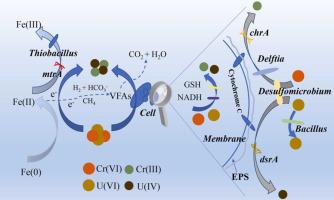Journal of Hazardous Materials ( IF 13.6 ) Pub Date : 2023-03-15 , DOI: 10.1016/j.jhazmat.2023.131222 Jianping Lu 1 , Rongyue Geng 1 , Han Zhang 1 , Zhen Yu 2 , Tao Chen 3 , Baogang Zhang 1

|
The co-presence of chromium (VI) [Cr(VI)] and uranium (VI) [U(VI)] is widely found in groundwater, imposing severe risks on human health. Although zerovalent iron [Fe(0)] supports superb performance for bioreduction of Cr(VI) and U(VI) individually, the biogeochemical process involving their concurrent removal with Fe(0) as electron donor remains unexplored. In the 6-d batch study, 86.1% ± 0.7% of Cr(VI) was preferentially eliminated, while 78.4% ± 0.5% of U(VI) removal was achieved simultaneously. Efficient removal of Cr(VI) (100%) and U(VI) (51.2% ∼ 100%) was also obtained in a continuous 160-d column experiment. As a result, Cr(VI) and U(VI) were reduced to less mobile Cr(III) and insoluble U(IV), respectively. 16 S rRNA sequencing was performed to investigate the dynamics of microbial community. Delftia, Acinetobacter, Pseudomonas and Desulfomicrobium were the major contributors mediating the bioreduction process. The initial Cr(VI) and hydraulic retention time (HRT) incurred pronounced effects on community diversity, which in turn altered the reactor’s performance. The enrichment of Cr(VI) resistance (chrA), U(VI) reduction (dsrA) and Fe(II) oxidation (mtrA) genes were observed by reverse transcription qPCR. Cytochrome c, glutathione and NADH as well as VFAs and gas metabolites also involved in the bioprocess. This study demonstrated a promising approach for removing the combined contaminants of Cr(VI) and U(VI) in groundwater.
中文翻译:

基于 Fe(0) 的自养生物过程同时还原净化地下水中的铬 (VI) 和铀 (VI)
铬 (VI) [Cr(VI)] 和铀 (VI) [U(VI)] 的共存广泛存在于地下水中,对人类健康构成严重威胁。尽管零价铁 [Fe(0)] 支持 Cr(VI) 和 U(VI) 单独生物还原的卓越性能,但涉及它们与 Fe(0) 作为电子供体同时去除的生物地球化学过程仍未探索。在 6 天的批次研究中,优先去除 86.1% ± 0.7% 的 Cr(VI),同时去除 78.4% ± 0.5% 的 U(VI)。在连续 160 天的柱实验中也获得了 Cr(VI) (100%) 和 U(VI) (51.2% ∼ 100%) 的有效去除。结果,Cr(VI) 和 U(VI) 分别被还原为流动性较低的 Cr(III) 和不溶性 U(IV)。进行 16 S rRNA 测序以研究微生物群落的动态。代尔夫提亚不动杆菌、假单胞菌和脱硫微生物是调节生物还原过程的主要贡献者。初始 Cr(VI) 和水力保留时间 (HRT) 对群落多样性产生显着影响,进而改变反应器的性能。通过逆转录 qPCR 观察到Cr(VI) 抗性 ( chrA )、U(VI) 还原 ( dsrA ) 和 Fe(II) 氧化 ( mtrA ) 基因的富集。细胞色素 c、谷胱甘肽和 NADH 以及 VFA 和气体代谢物也参与生物过程。本研究展示了一种去除地下水中 Cr(VI) 和 U(VI) 复合污染物的有前途的方法。


























 京公网安备 11010802027423号
京公网安备 11010802027423号